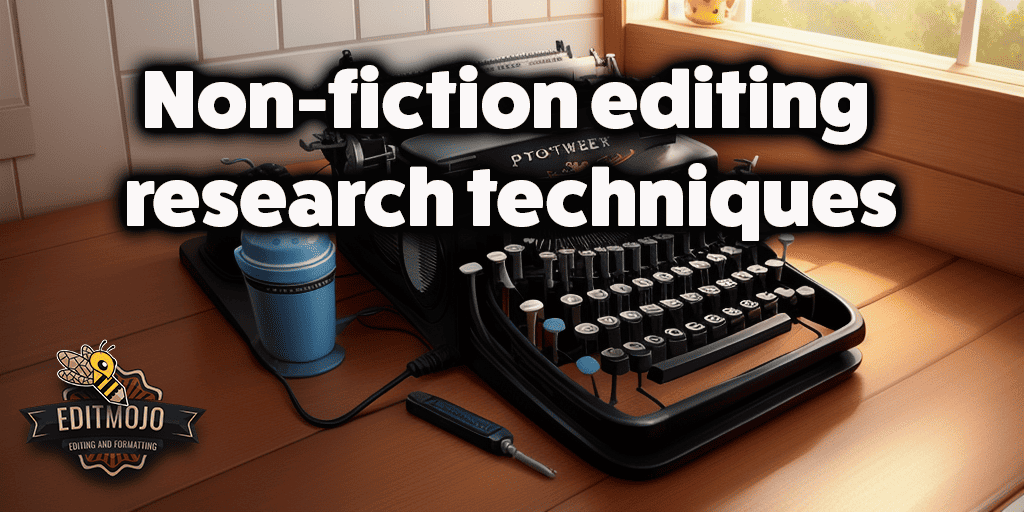Non-fiction editing research techniques
Non-fiction editing research techniques. When you’re immersed in the world of non-fiction editing, it’s not merely about polishing grammar, syntax, and punctuation. It’s a thorough process that involves diving deep into the core of the material and ensuring it’s accurate, credible, and compelling. This process is particularly important when it comes to research.
Understanding how to effectively research during the editing phase is crucial, and today, we’re here to break down the most efficient techniques for you.
1. Understand Your Topic
Understanding the topic at hand is the first and foremost step in non-fiction editing research. Even if you’re not an expert, having a basic knowledge of the subject matter will allow you to ask the right questions and know where to look for answers.
A good starting point is a general Google search to familiarize yourself with the topic. Make use of reliable resources like Google Scholar, academic databases, and authoritative websites to enhance your knowledge.

2. Verify Information
The next step is fact-checking. This is a crucial aspect of non-fiction editing that cannot be overstated. Regardless of the source of the information, it’s essential to verify the facts presented in the manuscript.
Cross-verify facts from multiple sources, including academic articles, government reports, and reputed news outlets. Tools like Snopes or FactCheck can also be used for this purpose.
3. Understand Context
Your research should also be geared towards understanding the context of the information presented. It’s important to assess if the writer’s interpretation of facts, statistics, or quotations is accurate and whether they fit in the larger context.
Using online databases and digital archives like JSTOR, ProQuest, or The New York Times Archive can help you find original sources and understand the context better.
4. Check the Validity of Sources
The validity of the sources used in the manuscript is another essential factor to consider. Ensure that the author has used reliable and authoritative sources.
You can use online source evaluation tools or follow the CRAAP Test (Currency, Relevance, Authority, Accuracy, Purpose), a popular method used to assess the reliability of a source.

5. Spotting and Correcting Biases
One of the key aspects of non-fiction editing research is identifying and correcting biases. Look out for any signs of subjective language, overgeneralization, or omission of essential information.
6. Evaluate Legal and Ethical Aspects
Lastly, it’s crucial to assess any potential **legal and ethical aspects** related to the content. This includes checking for plagiarism, ensuring proper attribution, and obtaining necessary permissions for copyrighted materials, if applicable.
You can use plagiarism detection tools like Turnitin or Grammarly to identify any instances of copied content.
Non-fiction editing research is a challenging yet rewarding process that requires diligence, attention to detail, and a solid understanding of the subject matter. By employing these six techniques, you’ll not only improve the quality of the work you edit but also make it more credible, accurate, and engaging for your readers.
Now that you’ve got the tools and knowledge at your disposal, it’s time to dive into the world of non-fiction editing research and make a lasting impact on the content you help bring to life.
Bonus Tips: Enhancing Your Non-Fiction Editing Research Skills
Here are a few additional tips to take your non-fiction editing research to the next level:
7. Develop a Research System
Organizing your research process is crucial for efficiency. Develop a system that works for you, such as using bookmarks, note-taking apps, or spreadsheets to keep track of sources, facts, and quotes. Tools like Evernote or Notion can help you stay organized throughout the editing process.

8. Collaborate with the Author
A collaborative approach can make the research process smoother and more effective. Establish open communication with the author and ask them for clarification or additional sources when needed. This will not only save time but also foster a better understanding of the author’s perspective.
9. Stay Updated with Industry News
Keep yourself updated with the latest news and developments in the subject area you’re editing. Subscribe to relevant newsletters, join professional associations, or follow industry influencers on social media. Staying informed will help you better assess the manuscript’s relevance and accuracy.
10. Continuous Learning
Editing and research are skills that can always be improved. Attend workshops, webinars, or conferences to refine your skills and stay updated on the latest editing and research techniques. You can also join online communities or forums where professionals discuss their experiences, challenges, and tips.
By implementing these bonus tips and the techniques discussed earlier, you will become a more effective non-fiction editor, ensuring that the content you work on is accurate, reliable, and engaging. Keep honing your skills and never stop learning, as the world of non-fiction editing research is ever-evolving and full of fascinating discoveries.
